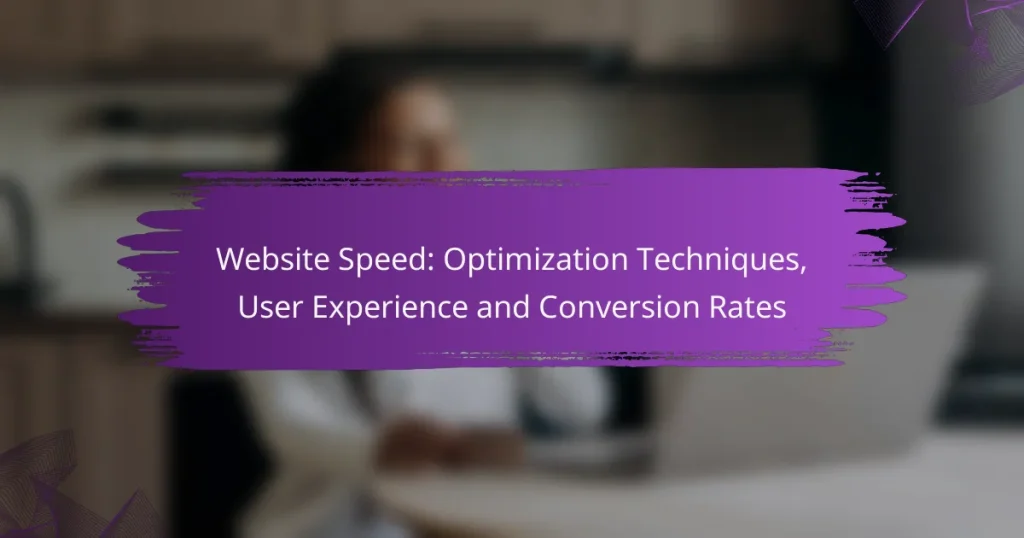Website speed is crucial for enhancing user experience and maximizing conversion rates. By implementing optimization techniques such as image compression, code minification, and effective caching strategies, businesses can ensure faster loading times that keep users engaged and satisfied. In today’s fast-paced digital landscape, even minor delays can lead to increased bounce rates and lost sales opportunities.
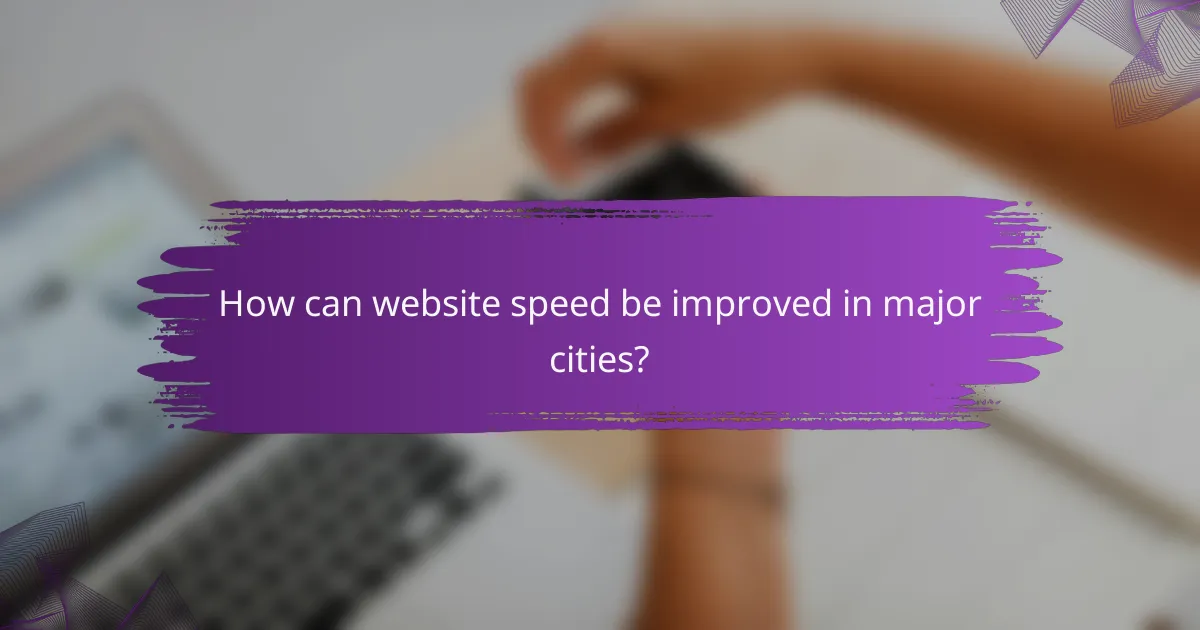
How can website speed be improved in major cities?
Improving website speed in major cities involves optimizing various technical aspects to enhance user experience and boost conversion rates. Key techniques include image optimization, minification of code, utilizing CDNs, enabling browser caching, and reducing server response time.
Image optimization techniques
Image optimization is crucial for reducing load times. Techniques such as compressing images, using appropriate file formats (like JPEG for photos and PNG for graphics), and implementing responsive images can significantly enhance performance. Aim for image sizes under 100 KB when possible to ensure faster loading.
Consider using tools like TinyPNG or ImageOptim to automate the compression process. Additionally, serving images in next-gen formats like WebP can further decrease file sizes without sacrificing quality.
Minification of CSS and JavaScript
Minification involves removing unnecessary characters from CSS and JavaScript files, such as whitespace and comments, to reduce file size. This can lead to faster downloads and improved load times. Tools like UglifyJS for JavaScript and CSSNano for CSS can help automate this process.
As a best practice, combine multiple CSS and JavaScript files into single files to reduce the number of HTTP requests. This is particularly beneficial in urban areas with high traffic, where every millisecond counts.
Utilizing Content Delivery Networks (CDNs)
CDNs distribute website content across multiple servers globally, allowing users to access data from the nearest location. This reduces latency and speeds up loading times, especially in densely populated cities. Popular CDN providers include Cloudflare and Akamai.
When selecting a CDN, consider factors like geographic coverage and integration with your existing infrastructure. A well-chosen CDN can improve load times by up to 50% in urban settings.
Enabling browser caching
Browser caching allows frequently accessed resources to be stored locally on a user’s device, reducing the need to download them again on subsequent visits. By setting appropriate cache headers, you can instruct browsers to store files for a specified duration.
Implement caching strategies for static assets like images, CSS, and JavaScript files. Aim for cache durations of at least one week for static content to enhance repeat visitor experience.
Reducing server response time
Server response time is the duration it takes for a server to respond to a user’s request. Factors influencing this include server performance, database queries, and application code efficiency. Aim for a response time under 200 milliseconds for optimal user experience.
To reduce server response time, consider upgrading your hosting plan, optimizing database queries, and using efficient coding practices. Regularly monitor server performance to identify and address bottlenecks promptly.

What is the impact of website speed on user experience?
Website speed significantly affects user experience by influencing how quickly visitors can access content. Faster loading times lead to higher satisfaction, while delays can frustrate users and drive them away.
Faster load times enhance user satisfaction
When a website loads quickly, users are more likely to have a positive experience. Studies show that even a one-second delay can lead to decreased user satisfaction and engagement. Aim for load times under three seconds to keep users happy.
To improve load times, consider optimizing images, leveraging browser caching, and minimizing HTTP requests. Tools like Google PageSpeed Insights can help identify specific areas for improvement.
Reduced bounce rates correlate with speed
Faster websites tend to have lower bounce rates, meaning visitors are less likely to leave after viewing only one page. A delay of just a few seconds can increase bounce rates significantly, often by tens of percent.
To reduce bounce rates, ensure your site loads quickly on both desktop and mobile devices. Regularly test your site’s performance and make adjustments based on user feedback and analytics data.
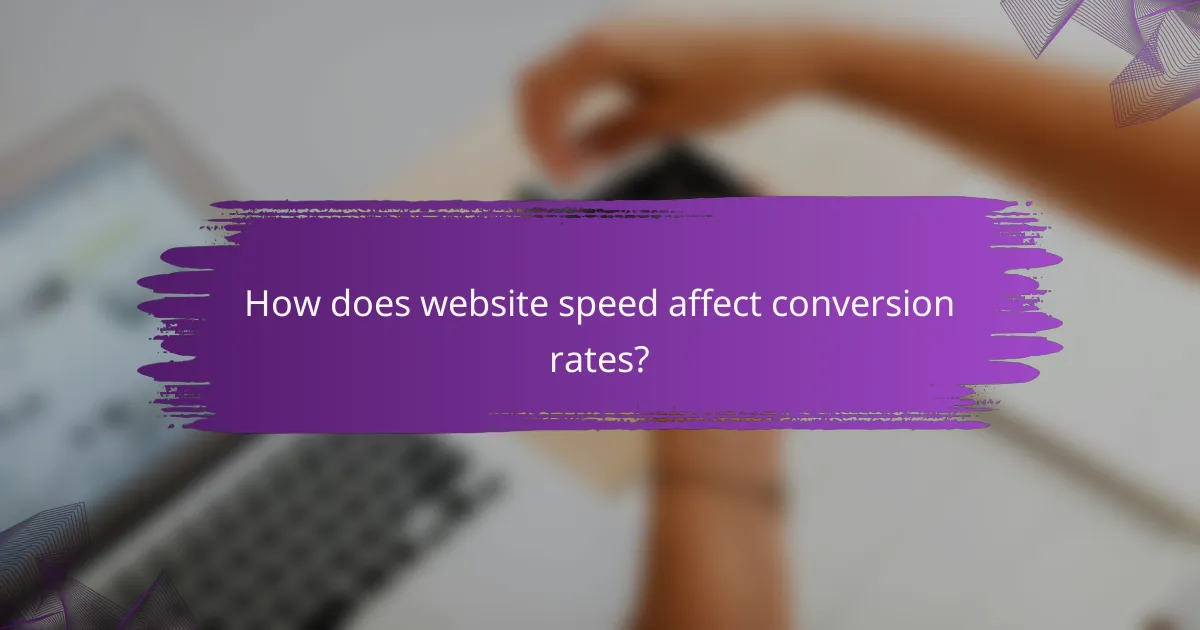
How does website speed affect conversion rates?
Website speed significantly impacts conversion rates, as slower loading times can lead to higher bounce rates and lost sales. Users expect quick access to information, and delays can frustrate potential customers, ultimately affecting their purchasing decisions.
Speed influences purchase decisions
When users encounter a slow website, they are more likely to abandon their shopping cart or search for alternatives. Research indicates that even a delay of a few seconds can deter customers from completing a purchase. This is particularly crucial in e-commerce, where every second counts in retaining customer interest.
For example, if an online store takes over three seconds to load, it may lose a significant portion of visitors who expect instant access. Ensuring that your website loads quickly can enhance user satisfaction and encourage more purchases.
Faster sites lead to higher conversion rates
Faster websites generally see improved conversion rates, as users are more likely to engage with content and complete transactions. Studies suggest that optimizing load times can lead to conversion increases of 20% or more. This correlation highlights the importance of speed in the overall user experience.
To achieve faster load times, consider optimizing images, leveraging browser caching, and minimizing HTTP requests. Regularly testing your website’s speed can help identify bottlenecks and areas for improvement, ensuring that you maintain a competitive edge in the market.

What tools can be used to measure website speed?
Several tools are available to measure website speed, each offering unique features and insights. These tools help identify performance bottlenecks and provide recommendations for optimization.
Google PageSpeed Insights
Google PageSpeed Insights analyzes the content of a web page and generates suggestions to make that page faster. It provides a score from 0 to 100, with higher scores indicating better performance. The tool evaluates both mobile and desktop versions, allowing you to see how your site performs across devices.
When using PageSpeed Insights, focus on the suggestions provided, such as optimizing images, leveraging browser caching, and reducing server response times. Implementing these recommendations can significantly enhance your site’s speed and user experience.
GTmetrix
GTmetrix offers a detailed analysis of your website’s speed and performance metrics. It combines data from Google Lighthouse and WebPageTest, providing insights into load times, total page size, and the number of requests made. Users can also track performance over time and compare results against competitors.
Utilize GTmetrix’s waterfall chart to identify which resources are slowing down your site. Pay attention to the recommendations for optimizing images, minifying CSS and JavaScript, and reducing redirects to improve loading times.
Pingdom Tools
Pingdom Tools provides a user-friendly interface for measuring website speed and performance. It offers insights into load times, performance grades, and a breakdown of page elements. You can test your site from various locations, which is useful for understanding how geographical factors affect speed.
When using Pingdom, focus on the performance grade and the suggestions provided for improvement. Common recommendations include optimizing images, minimizing HTTP requests, and utilizing a content delivery network (CDN) to enhance speed for users worldwide.
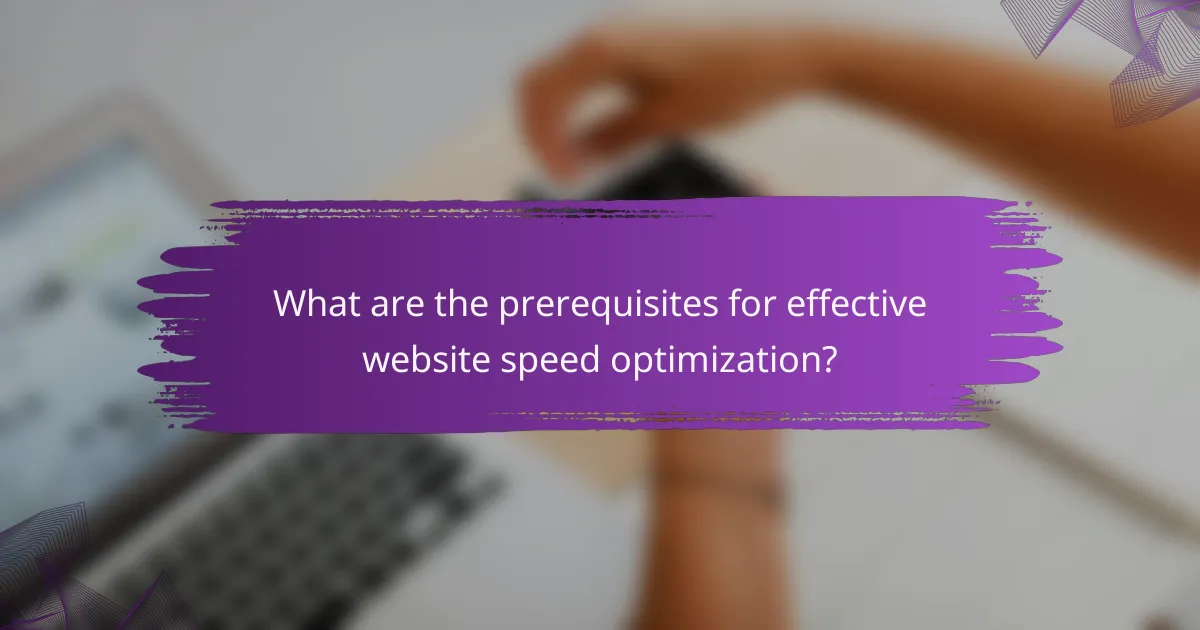
What are the prerequisites for effective website speed optimization?
Effective website speed optimization requires a solid understanding of both technical and user experience factors. Key prerequisites include a well-structured website architecture and the ability to identify critical rendering paths to ensure fast loading times.
Understanding website architecture
Website architecture refers to the structural design of a website, including its layout, navigation, and content organization. A clear and logical architecture helps users find information quickly, which can enhance their experience and reduce bounce rates.
To optimize speed, focus on minimizing the number of HTTP requests by consolidating files and using CSS sprites. Aim for a flat hierarchy where important pages are easily accessible within a few clicks, which can improve load times and user engagement.
Identifying critical rendering paths
The critical rendering path is the sequence of steps the browser takes to convert HTML, CSS, and JavaScript into a visible webpage. Understanding this path allows developers to prioritize the loading of essential resources, improving perceived performance.
To optimize the critical rendering path, consider deferring non-essential JavaScript and CSS that are not needed for the initial rendering. Tools like Google PageSpeed Insights can help identify blocking resources and suggest optimizations, such as inlining critical CSS or using asynchronous loading techniques.
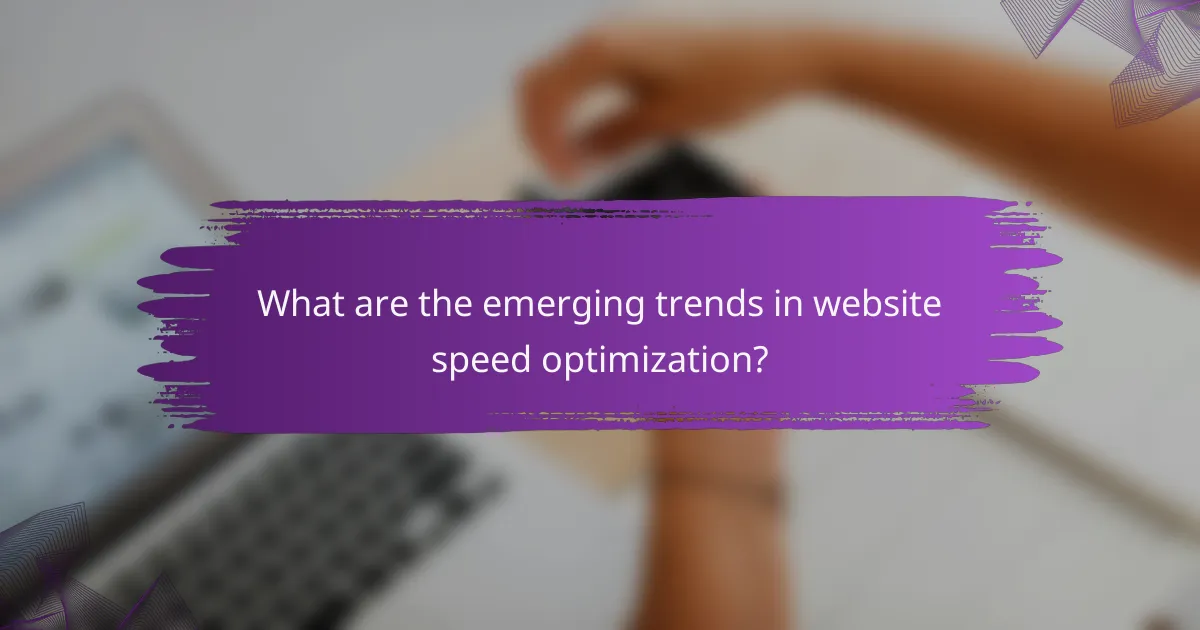
What are the emerging trends in website speed optimization?
Emerging trends in website speed optimization focus on enhancing user experience and improving conversion rates through innovative technologies and practices. Key strategies include adopting next-gen image formats, leveraging Content Delivery Networks (CDNs), and implementing lazy loading techniques.
Next-Gen Image Formats
Next-gen image formats like WebP and AVIF significantly reduce file sizes without compromising quality, leading to faster load times. Websites that switch to these formats can see improvements in speed, often reducing image loading times by up to 50% compared to traditional formats like JPEG and PNG.
When implementing next-gen formats, ensure that your website can serve fallback options for browsers that do not support them. Tools like ImageMagick or online converters can help in batch processing images to these formats.
Content Delivery Networks (CDNs)
Using a CDN distributes website content across multiple servers worldwide, minimizing latency by serving users from the nearest location. This can lead to load time reductions of several hundred milliseconds, which is crucial for retaining visitors.
Consider integrating a CDN that offers features like automatic caching and real-time analytics. Popular options include Cloudflare and Amazon CloudFront, which can enhance both speed and security.
Lazy Loading Techniques
Lazy loading defers the loading of non-essential resources until they are needed, which can significantly improve initial load times. By only loading images and videos when they enter the viewport, websites can reduce their initial payload and improve user engagement.
Implement lazy loading using native HTML attributes like loading=”lazy” or JavaScript libraries. This technique is particularly effective for content-heavy sites, as it allows for a smoother browsing experience without overwhelming users with data upfront.
